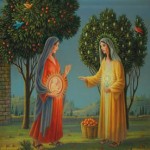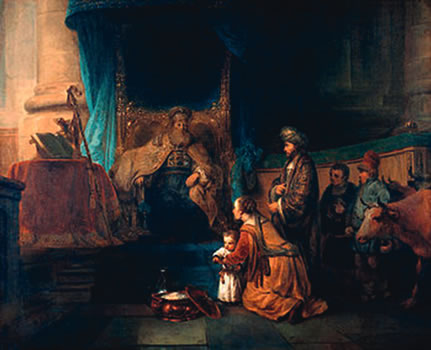Mary for Today:- A New World Vision – Mary Visits Elizabeth
The Visitation May 31st. Readings for this article: Luke 1:39-56 and 1 Samuel 1:1-2:10.
When Mary sings the Magnificat, she recalls the words of Hannah, the mother of Samuel, so as we read the passage we are in the company of three women (Hannah, Mary and Elizabeth). Hannah was one of the two wives of Elkanah. His other wife, Penninah, had children, but Hannah had none, and for this reason Elkanah gave Penninah preferential treatment, even though he loved Hannah more. Elkanah had trouble understanding Hannah’s longing for children, because he thought his love ought to be more than enough for her. Eli, the priest, seeing how fervently Hannah prayed in the temple, accused her of being drunk. Eventually Hannah promised a costly deal. If God would give her a son, she would dedicate him to God. Hannah’s hymn in the temple at the dedication of her son, Samuel, inspired the Magnificat. Rewarding her faithfulness, God blessed Hannah with several more children.
Why did Mary evoke Hannah, whose unseen presence lies behind the great hymn of thanksgiving that is the Magnificat? Hannah’s life manifests the suffering of women who are victims in a world where mutuality has given way to dominance and servility. African women sometimes speak of the discord, jealousy, and rivalry inherent in societies where there are several wives and a woman’s value lies in childbearing. Hannah lives in such a world; her spirituality is misinterpreted and condemned. Perhaps Mary found herself a figure of gossip in Nazareth, blamed for being pregnant outside of marriage. It would be easy for her to identify with Hannah’s lonely struggle.
Hannah’s world still survives, and the message of the Magnificat, rejoicing in God’s Kingdom made present to Mary in the dazzling light of her encounter with God, is for us still a light on the horizon, already but not yet. But from Hannah’s story we can sense some points about the world to come. From the OT, the book of the desert, we learn about barrenness and fertility, of barren women made fertile by God, such as Sarah, Hannah, and Elizabeth. For a small people, outnumbered by their enemies, living in a physical landscape of the wilderness, fruitfulness was a sign of God’s blessing. The fertile woman, like the fertile land, signaled God’s loving care for his people and his pledge for the future.
A Stewardship Truth
In both songs God’s presence is not so much in the physical function of childbearing, but in the creation of a world of justice and the ending of tyranny. As mothers they reinterpret the world, seeing in their own experience an affront to the arrogant and powerful and a vindication of the oppressed, those whom Hannah symbolized as ‘the barren woman’ of her song. A good community is one that mothers its people, teaching them to live together in harmony, nurturing the young and protecting the weak and old. If we understand stewardship as mothering the world rather than governing it, we will understand the role God assigned to Adam and Eve.
If that is what mothering is, what does barrenness mean? Hannah knew what it was to be regarded as worthless in the eyes of society. The barren woman is the person no longer valued as a productive member of society, barren because she longs to give of herself, her life and her love and vitality, but nobody wants what she has to offer. In our modern economy driven world, we are less and less able to speak of compassion, faith, and love, because the markets only allow us a political language of greed and self-interest. In the motherly community each one is known by name, treasured for their unique gifts, nurtured in their weakness and encouraged in their strength. But in the barren society, people become numbers, the mass media a substitute for creativity, and the moral weakness of the rich is used as a tool of oppression in the war against the powerless.
Hannah presenting her son Samuel to the priest
Elizabeth was the last barren woman mentioned in the Bible to experience God’s presence in the physical manifestation of pregnancy. Her child would announce that the kingdom of God was at hand, and in that Kingdom, with their personhood restored, women would become co-workers on an equal footing with men, not just in terms of their childbearing potential but as people of faith and vision. Of the women who come to Jesus for healing, we are not told of any who were barren. We know nothing of the maternal status of Martha and Mary, or Mary Magdalene. Jesus loves women not as bearers of children but as people of worth and dignity in their own right. Christ invites us all to become human beings who nurture one another, giving new life to the poor and unprotected in a brutal world. This is the only kind of fertility of enduring value in the Kingdom of God.
In Mary’s visit to Elizabeth, we see that pregnant women are chosen by God as the special bearers of his word. Hannah, the barren wife, was fertile and creative in the eyes of God. He gave her a new song to sing, a prophecy that would endure until her distant sister Mary took up her song and fulfilled it. God struck dumb the male priest, Zechariah, and restored the power of speech to pregnant women. The barren Hannah, the elderly Elizabeth, and the Virgin Mary stand before us, round-bellied and joyful, affirming the restoration of all women in every stage and condition of life to their rightful place in the human community.
The Visitation is often portrayed in a way that reinforces a certain dreary image of women as submissive and dutiful caregivers, with the young Mary ignoring her own discomfort to go and help her older cousin. Instead, imagine Mary setting out with wings on her heels to seek the companionship of the one person in all the world who would understand the uniqueness of her situation, and who would share in the delight of her pregnancy. In going to stay with Elizabeth, she found refuge away from the gossipers of Nazareth in the presence of a woman who was in every sense her soul mate. In Mary and Elizabeth we see the power of a friendship that was not a duty or a burden but a joyful expression of mutually affirming love.
The disciples of Jesus, then and now, were often locked in competition with one another for first place. There was no such rivalry between Mary and Elizabeth. Elizabeth recognized immediately the primacy of Mary’s calling, and her greeting to Mary was a radiant expression of generosity toward the younger woman. John the Baptist would inherit his mother’s humility, saying of Jesus, “I am not fit to kneel and undo the strap of his sandals.” God condemns hierarchies based on power, race, and gender, but there is a ranking of vocations and society would collapse without it. But Elizabeth and John teach us how to be gracious in second place, how to respond to greatness in others.
Mary and Elizabeth’s relationship is in direct contrast to that of Hannah and Penninah. In Hannah and Penninah, we see the bitterness and hurt, the jealousy and resentment that breed in an unjust environment. People need to feel valued and loved to be able to give themselves freely to others. Mary and Elizabeth, in the perfect assurance of God’s love for them, experienced a transformed and transforming friendship. In them, we see what women mean to one another in the redeemed community. Between them, these two had been given the power to change the world.
Source: Rediscovering Mary by Tina Beattie (Burns Oates/Dove). Ch.2.


 Entries(RSS)
Entries(RSS)